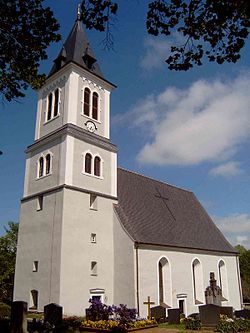Großdrebnitz
| Großdrebnitz | |
|---|---|
| Stadtteil of Bischofswerda | |

Martinskirche Grossdrebnitz
|
|
| Coordinates: 51°5′22″N 14°9′24″E / 51.08944°N 14.15667°ECoordinates: 51°5′22″N 14°9′24″E / 51.08944°N 14.15667°E | |
| Country | Germany |
| State | Saxony |
| District | Bautzen |
| Town | Bischofswerda |
| Elevation | 380 m (1,250 ft) |
| Population (2010-06-16) | |
| • Total | 883 |
| Time zone | CET/CEST (UTC+1/+2) |
| Postal codes | 01877 |
| Dialling codes | 03594 |
| Vehicle registration | BZ |
Großdrebnitz, in Sorbian language Drjewnica, is part of the city of Bischofswerda in the district of Bautzen, in Saxony, Germany. It stretches along 4 km from the river Wesenitz in the north to the foothills of Lausitzer Bergland in the south.
Today's Großdrebnitz consists of the two parts Großdrebnitz and Kleindrebnitz, which were unified 1936 and became part of Bischofswerda in 1996. In both parts farmland dominates. Moreover, Kleindrebnitz has a centuries-long tradition in fish farming.
Groß- and Kleindrebnitz (Drewenitz major, Drewenitz minor) were officially documented the first time in 1262. They belonged to the former Milceni area.
Some publications cite a first reference of Großdrebnitz already for 1007, when Henry II, Holy Roman Emperor donated a castellum to the Bishop of Meißen. This is not proved and no traces of a historical burgward were found in the village. Moreover, Doberschau claims this origin too, based on the same document.
Old records tell about people from Venice washing gold in Großdrebnitz. In the year 1559, when Augustus, Elector of Saxony had secularized the Stolpen territory of the Bishop of Meißen, the Amtsschösser was directed to search for gold in Großdrebnitz. Records from that time finally tell about silver which was mined near the church.,
...
Wikipedia

